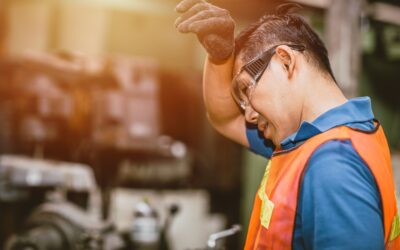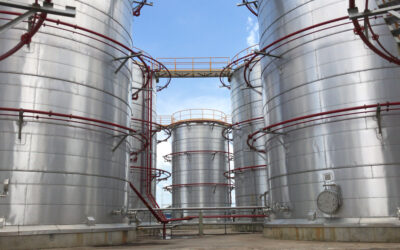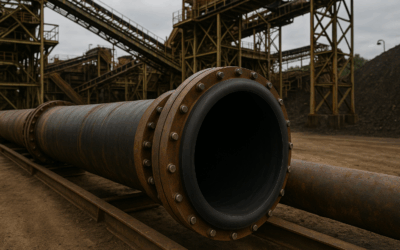Proper rubber lining is critical when protecting industrial equipment like tanks, pipes, and fittings. The thickness of the rubber lining affects durability, safety, and optimal performance.
Lining thickness makes all the difference in prolonging the lifespan of your equipment and reducing operational downtime, from resisting chemical corrosion to withstanding high-pressure and abrasive environments.
With so many factors to consider—like operating conditions, material compatibility, and industry-specific requirements—choosing the right thickness can feel overwhelming. We’re here to help.
Why Rubber Lining Thickness Matters
Rubber linings protect industrial equipment from damage caused by harsh operating conditions. Acting as a protective barrier, rubber linings shield equipment from chemical exposure, abrasion, and mechanical stress. They extend the lifespan of your assets and reduce costly repairs.
However, not all applications require the same thickness of rubber lining. The appropriate thickness ensures optimal performance by addressing specific challenges unique to each use case.
Here’s how the correct lining thickness impacts performance:
- Durability: Thicker linings reduce wear and tear by absorbing impacts and resisting deformation over time, ideal for high-stress environments.
- Chemical Resistance: Applications involving corrosive substances, such as acids or alkalis, require thicker linings for an extra layer of protection, preventing equipment from deteriorating under constant exposure.
- Abrasion Resistance: High-friction environments, like those found in mining or slurry transport, demand thicker linings to withstand the constant impact of abrasive particles like sand, rocks, or other materials.
- Pressure Handling: Tanks and vessels operating under high-pressure conditions benefit from linings that can endure the stress without cracking or compromising the equipment’s structural integrity.
5 Factors That Influence Rubber Lining Thickness Based on Application Needs
Selecting rubber lining thickness depends on the specific conditions your equipment will face.
Below are five common application scenarios, recommended thickness ranges, and the reasoning behind them.
1. Applications in Corrosive Environments
In highly corrosive environments, thicker linings provide a barrier against chemical degradation, so the equipment remains intact and functional over time.
- Example: Storage tanks handling strong acids (e.g., sulfuric acid in chemical plants).
- Recommended Thickness: 10-15mm, depending on acid concentration and temperature.
2. High-Abrasion Applications
Constant friction from abrasive particles like rocks and sand can quickly wear down thinner linings. Thick linings are essential to handle this continuous wear and tear and extend the equipment’s lifespan.
- Example: Pipes or fittings used in slurry transport in mining operations.
- Recommended Thickness: 12-20mm.
3. High-Pressure Systems
High-pressure environments place significant stress on equipment. Rubber lining is needed for structural reinforcement and to prevent cracks or failures under pressure.
- Example: Pressure vessels in oil and gas applications.
- Recommended Thickness: 8-15mm, based on pressure ratings and temperature ranges.
4. Applications in High-Temperature Environments
Elevated temperatures can accelerate wear and tear on lining. A thick, heat-resistant lining ensures durability and consistent performance over time.
- Example: Heat exchangers or vessels exposed to temperatures above 120°C.
- Recommended Thickness: 8-12mm with specialized rubber formulations.
5. Complex Equipment Geometries
Thin linings are easier to apply to curved or intricate surfaces without compromising durability. This makes them ideal for complex equipment shapes requiring flexibility and precision.
- Example: Agitators and mixers in food processing or pharmaceutical industries.
- Recommended Thickness: 6-10mm.
Typical Rubber Lining Thickness Ranges by Industry
As you can see, rubber lining requirements vary significantly depending on the challenges associated with specific applications.
Here’s a quick guide to typical thickness ranges by industry:
Chemical Processing
Chemical processing environments demand robust chemical resistance to prevent degradation and ensure the longevity of equipment.
- Typical Thickness: 8-15mm
- Applications: Tanks and pipelines handling corrosive substances like acids or alkalis.
Mining and Aggregates
The constant friction and impact in these mining settings require thicker linings to withstand wear and tear.
- Typical Thickness: 12-20mm
- Applications: Chutes, slurry pipelines, and equipment exposed to high levels of abrasion from sand, rocks, and other materials.
Oil & Gas
These conditions require linings that can handle both thermal stress and mechanical pressure without compromising performance.
- Typical Thickness: 10-15mm
- Applications: Pressure vessels, pipelines, and equipment exposed to high temperatures or pressure variations.
Food & Beverage
Thinner linings are ideal for easy cleaning in the food and beverage industry, ensuring compliance with hygiene standards while maintaining durability.
- Typical Thickness: 6-10mm
- Applications: Sanitary linings in mixers, storage tanks, and other food-grade equipment.
How to Select the Right Rubber Lining Thickness for Your Needs
Follow these steps to confidently choose the right rubber lining thickness to enhance your equipment’s durability, safety, and performance. For expert advice, US Rubber is here to remove the guesswork from your selection process.
1. Assess Operating Conditions
Begin by identifying the primary stress factors your equipment will face. Consider the following:
- Chemical Resistance: Will the equipment handle corrosive substances?
- Abrasion Resistance: Will it be exposed to high-friction materials like sand or rocks?
- Thermal Stress: Will it operate under high temperatures?
- Mechanical Pressure: Will it need to withstand significant mechanical or hydraulic pressure?
2. Consult Material Compatibility Charts
Different rubber materials are designed to handle specific challenges. Consult compatibility charts to match the lining material and thickness to your environment. For example:
- Use acid-proof rubber for chemical storage tanks.
- Opt for abrasion-resistant rubber for mining and slurry transport applications.
3. Evaluate Long-Term Costs
Thick linings may have a higher upfront cost but can reduce maintenance expenses and downtime over time. Consider the total cost of ownership, especially for applications where frequent replacement or repairs would disrupt operations or increase costs.
4. Leverage Expert Insights
Consulting with industry professionals like US Rubber ensures your selection is tailored to your needs. With expertise in rubber lining applications, US Rubber can:
- Analyze your specific requirements.
- Recommend the best material and thickness.
- Provide turnkey solutions, from procurement to installation.
Partner with US Rubber for Superior Rubber Lining Solutions
US Rubber offers unmatched expertise and comprehensive services when protecting industrial equipment. Our custom rubber lining solutions ensure tailored thickness options for corrosive, high-abrasion, high-pressure, and high-temperature applications.
Whether you need new installations or repairs, our experienced field crews deliver exceptional results on-site for tanks, vessels, and specialty equipment. Our expertise extends to both industrial rubber linings and rubber tank lining thickness, making us the go-to choice for diverse industries.
With US Rubber’s turnkey services, you’ll benefit from:
- Reduced Downtime: Efficient installation and repair processes to keep your operations running smoothly.
- Enhanced Performance: High-quality linings that optimize your equipment’s durability and efficiency.
- Peace of Mind: Guaranteed quality and safety standards you can trust.
Contact us today for a consultation or to learn more about how we can help with your rubber tank lining needs.







